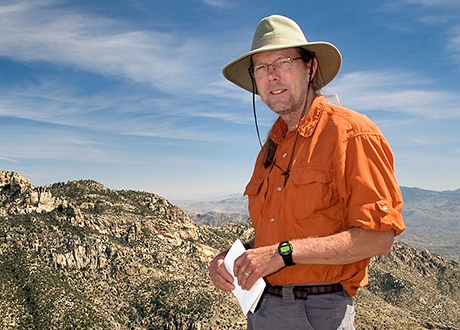UV Florescence Scorpion - Chip Hedgcock FBCA
© Chip Hedgcock
2008 BioImages Citation of Merit
This photo is of an unusual "twin-tailed" scorpion found in Southern Arizona near the Mexican border, taken by Charles "Chip" Hedgcock at the laboratory field office of the Sonoran Arthropod Studies Institute. Scorpions with two tails rarely survive to become adults, making this adult female highly unusual.
"The scorpion was placed on a piece of scar tissue from a fallen Saguaro cactus inside a shallow plastic enclosure. Because this photo was taken in a laboratory, I had total control over the ambient light. The room was darkened and I used a powerful flash unit with a visibly opaque filter that only passed Ultra Violet light. This allowed me to capture the Ultra Violet Fluorescence peculiar to scorpions as well as freeze the scorpion's movement."
"The purpose of the image was to document this rare occurrence of an adult Bark scorpion with a bifurcated tail while accurately illustrating the green fluorescence that scorpions are famous for when illuminated with an Ultra Violet light."
Read more about this photographer

Photo credit: Tom Kirkendall, Kirkendall/Spring Photography
Charles "Chip" Hedgcock studied photography in the Fine Art Department at Pima Community College before attending Brooks Institute in Santa Barbara, California, where he earned a degree in Commercial Photography.
He has worked in the BioMedical Communications Department at the University Medical Center in Tucson and the Department of Neurobiology at the University of Arizona. He is also a Registered Biological Photographer, a certification he earned through the BCA.
Below, Hedgcock shares insight into his specialty of life science/natural science photography and advice for other photographers interested in entering this field.
Why did you choose this as your specialty?
My interest has long been in natural history and the environment, so on the side I have always pursued projects with researchers in Herpetology and Entomology working on projects in the field. I enjoy contributing to a greater understanding and appreciation of the natural world.
What type of cameras do you shoot with?
I shoot with a variety of cameras from digital SLR's and film SLR's to large format view cameras. The intended use of the images is the determining factor in which camera type I use.
What is your favorite piece of equipment or photography accessory? Why?
I am still very fond of the darkroom for my personal work.
Describe your typical workday.
Each project is different so it's hard to say exactly, but my latest endeavor, working as the primary photographer on a series of biological assessments with the Sky Island Alliance in Mexico would go something like: Up early & load my pack with food, water, collecting and camera gear for a long day in the field. The day would be spent searching for lizards and snakes, while making note of other animals, interesting plants and habitats we encounter.
We may cover many miles in very rough terrain during the day. Lizards and snakes encountered would be captured and voucher photographs taken. GPS coordinates and other field notes relative to the animal are taken. I would also document the habitat types we pass through and document the activities of the other researchers I am with. We would return to camp at dinner time.
After dinner I set up a field studio to photograph items brought back from the field by other groups of biologist that day. These could be other lizards and snakes, plants, skulls or other bones etc. This is all done in the dark via headlamp using battery powered strobe units and a small aquarium for the live animals. The animals are returned to their point of capture the next morning.
I may then spend a few very late hours with the entomologist at his light sheet photographing interesting, rare and unusual arthropods that come to his sheet.
Do you have any advice for photographers interested in a career in life science or natural science photography?
As well as my degree in commercial photography from Brooks, I have taken classes in entomology and herpetology. I feel that more than half of being a successful natural science photographer comes from knowing and understand the animals you will be asked to photograph. Understanding an animal's behavior is key to a successful photograph.
